rims Seat Altea Freetrack 2013 Owner's Manual
[x] Cancel search | Manufacturer: SEAT, Model Year: 2013, Model line: Altea Freetrack, Model: Seat Altea Freetrack 2013Pages: 301, PDF Size: 4.45 MB
Page 143 of 301
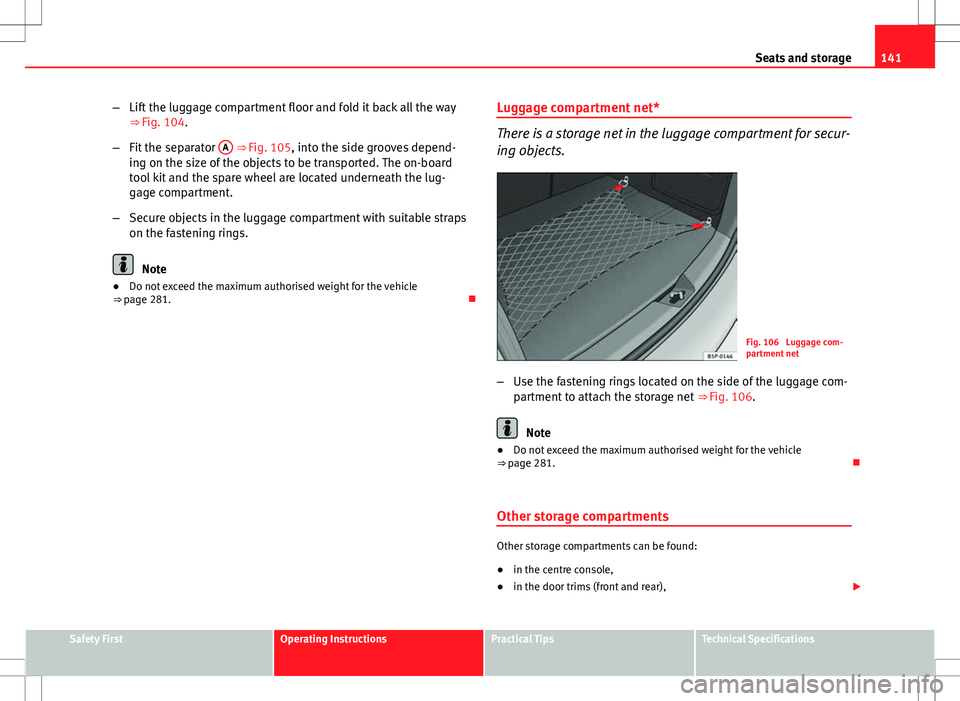
141
Seats and storage
– Lift the luggage compartment floor and fold it back all the way
⇒ Fig. 104.
– Fit the separator A
⇒ Fig. 105, into the side grooves depend-
ing on the size of the objects to be transported. The on-board
tool kit and the spare wheel are located underneath the lug-
gage compartment.
– Secure objects in the luggage compartment with suitable straps
on the fastening rings.
Note
● Do not exceed the maximum authorised weight for the vehicle
⇒ page 281. Luggage compartment net*
There is a storage net in the luggage compartment for secur-
ing objects.
Fig. 106 Luggage com-
partment net
– Use the fastening rings located on the side of the luggage com-
partment to attach the storage net ⇒ Fig. 106.
Note
● Do not exceed the maximum authorised weight for the vehicle
⇒ page 281.
Other storage compartments
Other storage compartments can be found:
● in the centre console,
● in the door trims (front and rear),
Safety FirstOperating InstructionsPractical TipsTechnical Specifications
Page 144 of 301
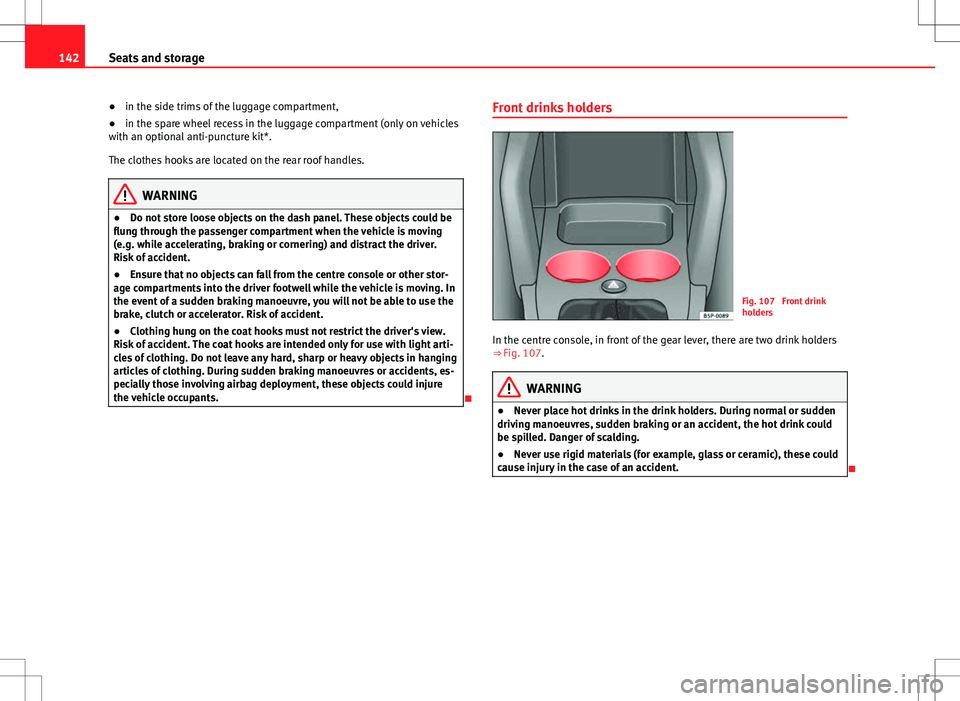
142Seats and storage
● in the side trims of the luggage compartment,
● in the spare wheel recess in the luggage compartment (only on vehicles
with an optional anti-puncture kit*.
The clothes hooks are located on the rear roof handles.
WARNING
● Do not store loose objects on the dash panel. These objects could be
flung through the passenger compartment when the vehicle is moving
(e.g. while accelerating, braking or cornering) and distract the driver.
Risk of accident.
● Ensure that no objects can fall from the centre console or other stor-
age compartments into the driver footwell while the vehicle is moving. In
the event of a sudden braking manoeuvre, you will not be able to use the
brake, clutch or accelerator. Risk of accident.
● Clothing hung on the coat hooks must not restrict the driver's view.
Risk of accident. The coat hooks are intended only for use with light arti-
cles of clothing. Do not leave any hard, sharp or heavy objects in hanging
articles of clothing. During sudden braking manoeuvres or accidents, es-
pecially those involving airbag deployment, these objects could injure
the vehicle occupants.
Front drinks holders
Fig. 107 Front drink
holders
In the centre console, in front of the gear lever, there are two drink holders
⇒ Fig. 107.
WARNING
● Never place hot drinks in the drink holders. During normal or sudden
driving manoeuvres, sudden braking or an accident, the hot drink could
be spilled. Danger of scalding.
● Never use rigid materials (for example, glass or ceramic), these could
cause injury in the case of an accident.
Page 212 of 301
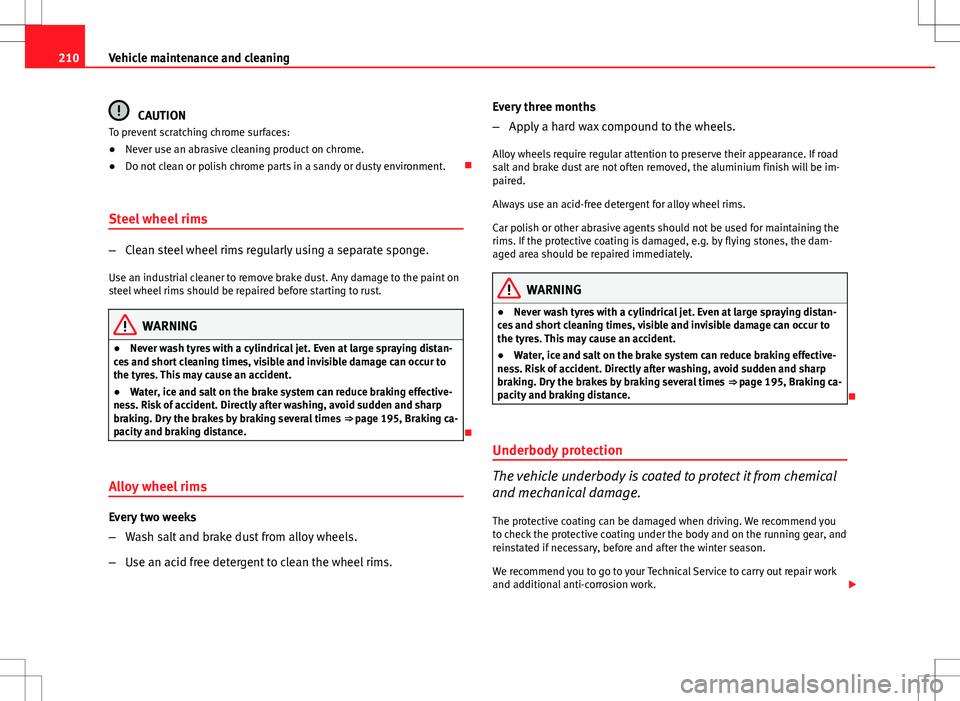
210Vehicle maintenance and cleaning
CAUTION
To prevent scratching chrome surfaces:
● Never use an abrasive cleaning product on chrome.
● Do not clean or polish chrome parts in a sandy or dusty environment.
Steel wheel rims
– Clean steel wheel rims regularly using a separate sponge.
Use an industrial cleaner to remove brake dust. Any damage to the paint on
steel wheel rims should be repaired before starting to rust.
WARNING
● Never wash tyres with a cylindrical jet. Even at large spraying distan-
ces and short cleaning times, visible and invisible damage can occur to
the tyres. This may cause an accident.
● Water, ice and salt on the brake system can reduce braking effective-
ness. Risk of accident. Directly after washing, avoid sudden and sharp
braking. Dry the brakes by braking several times ⇒ page 195, Braking ca-
pacity and braking distance.
Alloy wheel rims
Every two weeks
– Wash salt and brake dust from alloy wheels.
– Use an acid free detergent to clean the wheel rims. Every three months
–
Apply a hard wax compound to the wheels.
Alloy wheels require regular attention to preserve their appearance. If road
salt and brake dust are not often removed, the aluminium finish will be im-
paired.
Always use an acid-free detergent for alloy wheel rims.
Car polish or other abrasive agents should not be used for maintaining the
rims. If the protective coating is damaged, e.g. by flying stones, the dam-
aged area should be repaired immediately.
WARNING
● Never wash tyres with a cylindrical jet. Even at large spraying distan-
ces and short cleaning times, visible and invisible damage can occur to
the tyres. This may cause an accident.
● Water, ice and salt on the brake system can reduce braking effective-
ness. Risk of accident. Directly after washing, avoid sudden and sharp
braking. Dry the brakes by braking several times ⇒ page 195, Braking ca-
pacity and braking distance.
Underbody protection
The vehicle underbody is coated to protect it from chemical
and mechanical damage.
The protective coating can be damaged when driving. We recommend you
to check the protective coating under the body and on the running gear, and
reinstated if necessary, before and after the winter season.
We recommend you to go to your Technical Service to carry out repair work
and additional anti-corrosion work.
Page 213 of 301

211
Vehicle maintenance and cleaning
WARNING
Do not apply underseal or anti-corrosion coatings to the exhaust pipes,
catalytic converter or the heat shields on the exhaust system. The heat of
the exhaust system or the engine could cause them to ignite. Risk of fire.
Cleaning the engine compartment
Take special care when cleaning the engine compartment.
Anti-corrosion treatment
The engine compartment and the surface of the power unit are given anti-
corrosion treatment at the factory.
Good corrosion protection is particularly important in winter when the vehi-
cle is frequently driven on salted roads. To prevent the salt corroding the ve-
hicle, the entire engine compartment should be thoroughly cleaned before
and after winter.
Your Technical Services have got the necessary workshop equipment to pro-
vide the correct cleaning and preserving products. For this reason, we rec-
ommend having this work performed by them.
The anti-corrosion protection is usually removed if the engine compartment
is cleaned with grease removing solutions, or if you have the engine
cleaned. On commissioning this work, ensure that all surfaces, seams,
joints and components in the engine compartment are given anti-corrosion
treatment.
WARNING
● When working in the engine compartment, always observe the safety
warnings ⇒ page 222.
● Before opening the bonnet, switch the engine off, apply the hand-
brake firmly and always remove the key from the ignition.
● Allow the engine to cool before you clean the engine compartment.
● Do not clean the vehicle underbody, wheel arches or wheel trims
without protecting your hands and arms. You may cut yourself on sharp-
edged metal parts. Failure to comply could result in injury.
● Moisture, ice and salt on the brake system may affect braking effec-
tiveness. Risk of accident. Directly after washing, avoid sudden and
sharp braking.
● Never touch the radiator fan. It is temperature-controlled and could
start automatically, even when the key is removed from the ignition!
For the sake of the environment
Fuel, grease and oil deposits could be removed when the engine is washed.
The polluted water must be cleaned in an oil separator. For this reason, en-
gine washing should be carried out only by a specialised workshop or a pet-
rol station.
Vehicle interior maintenance Introduction
The dye used in many modern garments, for example dark jeans, is not al-
ways sufficiently colour-fast. Seat upholstery (material and leather), espe-
cially when light-coloured, may visibly discolour if the dye comes out of
clothing (even when used correctly). This is not an upholstery defect but in-
dicates that the dye in the item of clothing is not sufficiently colour-fast.
Safety FirstOperating InstructionsPractical TipsTechnical Specifications
Page 241 of 301
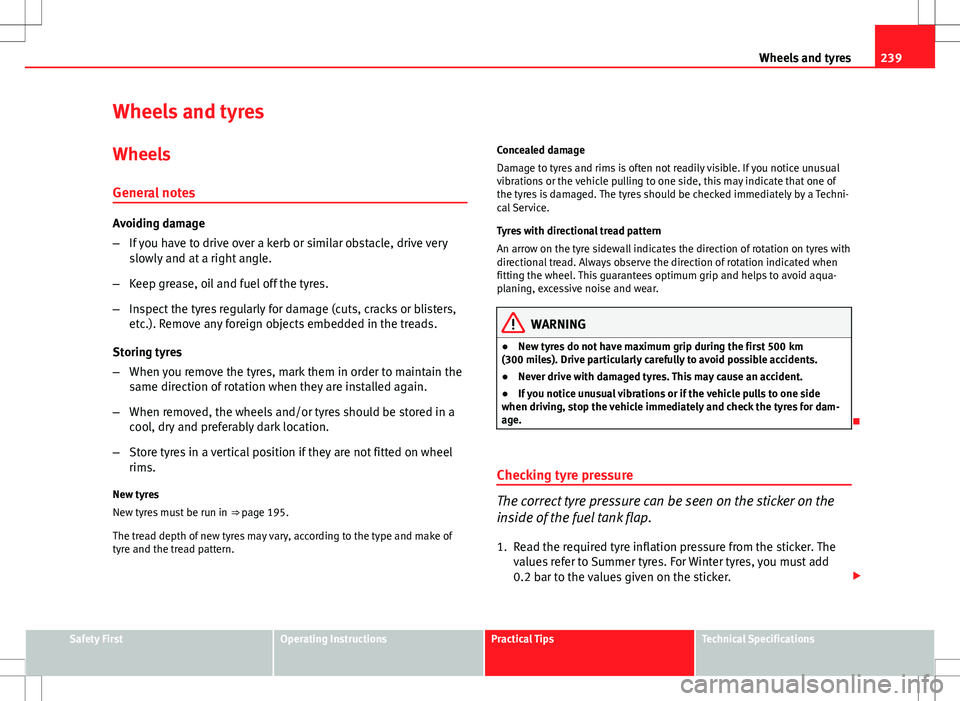
239
Wheels and tyres
Wheels and tyres
Wheels
General notes
Avoiding damage
– If you have to drive over a kerb or similar obstacle, drive very
slowly and at a right angle.
– Keep grease, oil and fuel off the tyres.
– Inspect the tyres regularly for damage (cuts, cracks or blisters,
etc.). Remove any foreign objects embedded in the treads.
Storing tyres
– When you remove the tyres, mark them in order to maintain the
same direction of rotation when they are installed again.
– When removed, the wheels and/or tyres should be stored in a
cool, dry and preferably dark location.
– Store tyres in a vertical position if they are not fitted on wheel
rims.
New tyres
New tyres must be run in ⇒ page 195.
The tread depth of new tyres may vary, according to the type and make of
tyre and the tread pattern. Concealed damage
Damage to tyres and rims is often not readily visible. If you notice unusual
vibrations or the vehicle pulling to one side, this may indicate that one of
the tyres is damaged. The tyres should be checked immediately by a Techni-
cal Service.
Tyres with directional tread pattern
An arrow on the tyre sidewall indicates the direction of rotation on tyres with
directional tread. Always observe the direction of rotation indicated when
fitting the wheel. This guarantees optimum grip and helps to avoid aqua-
planing, excessive noise and wear.
WARNING
● New tyres do not have maximum grip during the first 500 km
(300 miles). Drive particularly carefully to avoid possible accidents.
● Never drive with damaged tyres. This may cause an accident.
● If you notice unusual vibrations or if the vehicle pulls to one side
when driving, stop the vehicle immediately and check the tyres for dam-
age.
Checking tyre pressure
The correct tyre pressure can be seen on the sticker on the
inside of the fuel tank flap. 1. Read the required tyre inflation pressure from the sticker. The values refer to Summer tyres. For Winter tyres, you must add
0.2 bar to the values given on the sticker.
Safety FirstOperating InstructionsPractical TipsTechnical Specifications
Page 246 of 301
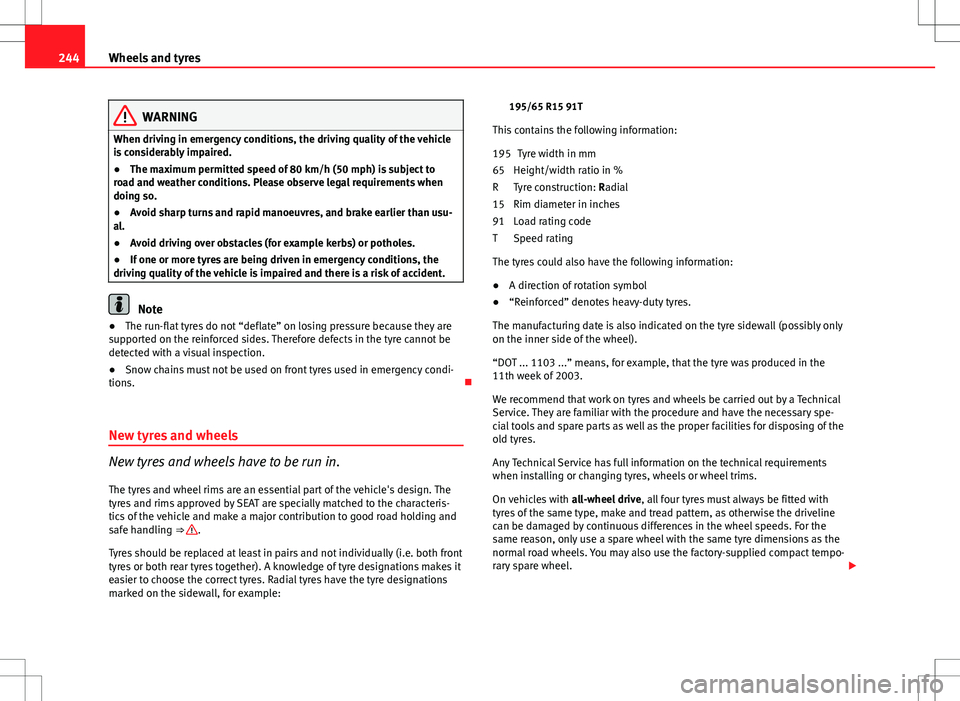
244Wheels and tyres
WARNING
When driving in emergency conditions, the driving quality of the vehicle
is considerably impaired.
● The maximum permitted speed of 80 km/h (50 mph) is subject to
road and weather conditions. Please observe legal requirements when
doing so.
● Avoid sharp turns and rapid manoeuvres, and brake earlier than usu-
al.
● Avoid driving over obstacles (for example kerbs) or potholes.
● If one or more tyres are being driven in emergency conditions, the
driving quality of the vehicle is impaired and there is a risk of accident.
Note
● The run-flat tyres do not “deflate” on losing pressure because they are
supported on the reinforced sides. Therefore defects in the tyre cannot be
detected with a visual inspection.
● Snow chains must not be used on front tyres used in emergency condi-
tions.
New tyres and wheels
New tyres and wheels have to be run in.
The tyres and wheel rims are an essential part of the vehicle's design. The
tyres and rims approved by SEAT are specially matched to the characteris-
tics of the vehicle and make a major contribution to good road holding and
safe handling ⇒
.
Tyres should be replaced at least in pairs and not individually (i.e. both front
tyres or both rear tyres together). A knowledge of tyre designations makes it
easier to choose the correct tyres. Radial tyres have the tyre designations
marked on the sidewall, for example: 195/65 R15 91T
This contains the following information: Tyre width in mm
Height/width ratio in %
Tyre construction: Radial
Rim diameter in inches
Load rating code
Speed rating
The tyres could also have the following information:
● A direction of rotation symbol
● “Reinforced” denotes heavy-duty tyres.
The manufacturing date is also indicated on the tyre sidewall (possibly only
on the inner side of the wheel).
“DOT ... 1103 ...” means, for example, that the tyre was produced in the
11th week of 2003.
We recommend that work on tyres and wheels be carried out by a Technical
Service. They are familiar with the procedure and have the necessary spe-
cial tools and spare parts as well as the proper facilities for disposing of the
old tyres.
Any Technical Service has full information on the technical requirements
when installing or changing tyres, wheels or wheel trims.
On vehicles with all-wheel drive, all four tyres must always be fitted with
tyres of the same type, make and tread pattern, as otherwise the driveline
can be damaged by continuous differences in the wheel speeds. For the
same reason, only use a spare wheel with the same tyre dimensions as the
normal road wheels. You may also use the factory-supplied compact tempo-
rary spare wheel.
195
65
R
15
91
T
Page 247 of 301

245
Wheels and tyres
WARNING
● We recommend that you use only wheels and tyres which have been
approved by SEAT for your model. Failure to do so could impair vehicle
handling. Risk of accident.
● Avoid running the vehicle on tyres that are more than 6 years old. If
you have no alternative, you should drive slowly and with extra care at all
times.
● Never use old tyres or those with an unknown history of use.
● If wheel trims are retrofitted, you must ensure that the flow of air to
the brakes is not restricted. This could cause the brake system to over-
heat.
● All four wheels must be fitted with radial tyres of the same type, size
(rolling circumference) and the same tread pattern.
For the sake of the environment
Old tyres must be disposed of according to the laws in the country con-
cerned.
Note
● For technical reasons, it is not generally possible to use the wheels from
other vehicles. This can also apply to wheels of the same model. The use of
wheels or tyres which have not been approved by SEAT for use with your
model may invalidate the vehicle's type approval for use on public roads.
● If the spare tyre is not the same as the tyres that are mounted on the
vehicle (e.g. winter tyres) you should only use the spare tyre for a short peri-
od of time and drive with extra care. Refit the normal road wheel as soon as
possible. Wheel bolts
Wheel bolts must be tightened to the correct torque.
The design of wheel bolts is matched to the rims. If different wheel rims are
fitted, the correct wheel bolts with the right length and correctly shaped
bolt heads must be used. This ensures that wheels are fitted securely and
that the brake system functions correctly.
In certain circumstances, you should not use wheel bolts from a different
vehicle, even if it is the same model ⇒ page 217.
After the wheels have been changed, the tightening torque of the wheel
bolts should be checked as soon as possible with a torque wrench ⇒
.
The tightening torque for steel and alloy wheels is 120 Nm.
WARNING
If the wheel bolts are not tightened correctly, the wheel could become
loose while driving. Risk of accident.
● The wheel bolts must be clean and turn easily. Never apply grease or
oil to them.
● Use only wheel bolts which belong to the wheel.
● If the tightening torque of the wheel bolts is too low, they could loos-
en whilst the vehicle is in motion. Risk of accident! If the tightening tor-
que is too high, the wheel bolts and threads can be damaged.
CAUTION
The prescribed tightening torque for wheel bolts for steel and alloy wheels
is 120 Nm.
Safety FirstOperating InstructionsPractical TipsTechnical Specifications
Page 253 of 301
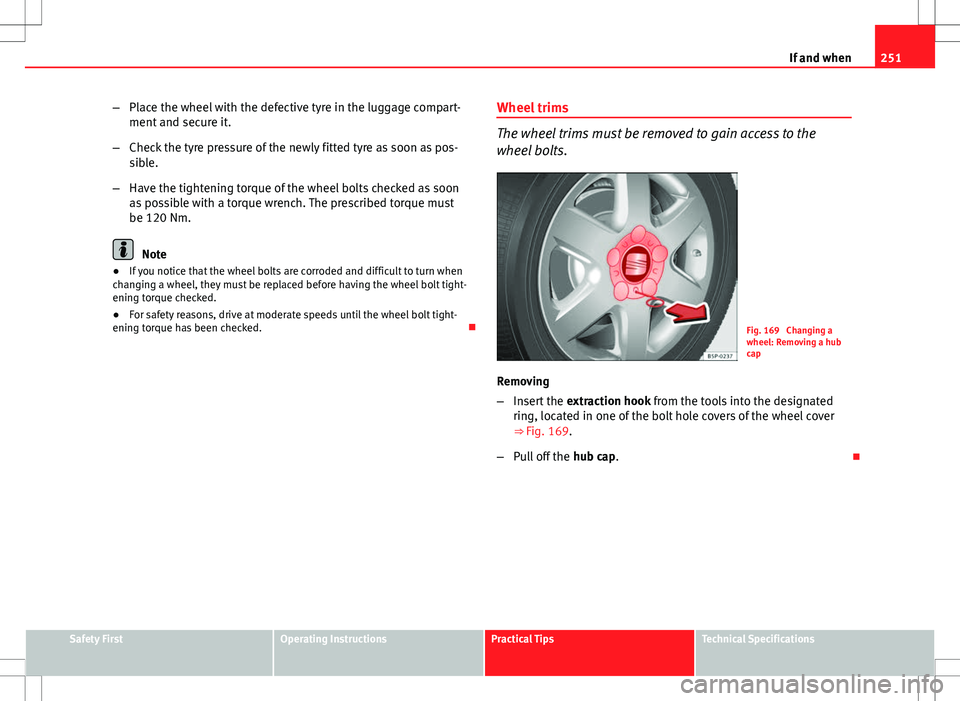
251
If and when
– Place the wheel with the defective tyre in the luggage compart-
ment and secure it.
– Check the tyre pressure of the newly fitted tyre as soon as pos-
sible.
– Have the tightening torque of the wheel bolts checked as soon
as possible with a torque wrench. The prescribed torque must
be 120 Nm.
Note
● If you notice that the wheel bolts are corroded and difficult to turn when
changing a wheel, they must be replaced before having the wheel bolt tight-
ening torque checked.
● For safety reasons, drive at moderate speeds until the wheel bolt tight-
ening torque has been checked. Wheel trims
The wheel trims must be removed to gain access to the
wheel bolts.
Fig. 169 Changing a
wheel: Removing a hub
cap
Removing
– Insert the extraction hook from the tools into the designated
ring, located in one of the bolt hole covers of the wheel cover
⇒ Fig. 169.
– Pull off the hub cap.
Safety FirstOperating InstructionsPractical TipsTechnical Specifications
Page 292 of 301

C
Car care Exterior . . . . . . . . . . . . . . . . . . . . . . . . . . . . 206
Catalytic converter . . . . . . . . . . . . . . . . . . . . . . 196
CCS . . . . . . . . . . . . . . . . . . . . . . . . . . . . . . . . . . 183
CD changer . . . . . . . . . . . . . . . . . . . . . . . . . . . . 138
Central lock button Locking . . . . . . . . . . . . . . . . . . . . . . . . . . . . . 97
Unlocking . . . . . . . . . . . . . . . . . . . . . . . . . . . 97
Central locking . . . . . . . . . . . . . . . . . . . . . . . . . . 95 Automatic locking system for involuntaryunlocking . . . . . . . . . . . . . . . . . . . . . . . . . . 97
Automatic speed dependent locking and unlocking system* . . . . . . . . . . . . . . . . . . 97
Emergency unlocking system . . . . . . . . . . . 97
Selective unlocking system* . . . . . . . . . . . . 96
Unlocking system* . . . . . . . . . . . . . . . . . . . . 97
Centre armrest . . . . . . . . . . . . . . . . . . . . . . . . . 138
Cetane number . . . . . . . . . . . . . . . . . . . . . . . . . 221
Changing gear see Manual gearbox . . . . . . . . . . . . . . . . . . 174
Changing gear in tiptronic mode . . . . . . . . . . 178
Changing the bulbs Main headlight bulbs . . . . . . . . . . . . . . . . . 263
Tail lights . . . . . . . . . . . . . . . . . . . . . . . . . . 266
Changing the main headlight bulbs Main beam lights . . . . . . . . . . . . . . . . . . . . 265
Side lights . . . . . . . . . . . . . . . . . . . . . . . . . . 266
Turn signal bulbs . . . . . . . . . . . . . . . . . . . . 264
Changing the main headlight lamps dipped lights . . . . . . . . . . . . . . . . . . . . . . . 264 Changing the tail light bulbs
Position light, fog light and tail light on therear lid . . . . . . . . . . . . . . . . . . . . . . . . . . . 268
Changing the tail lights Luggage compartment lights . . . . . . . . . . 269
Turn signal, side and brake lights on thebody . . . . . . . . . . . . . . . . . . . . . . . . . . . . . 267
Changing windscreen wiper blades . . . . . . . . 232
Chassis number . . . . . . . . . . . . . . . . . . . . . . . . 278
Checking . . . . . . . . . . . . . . . . . . . . . . . . . . . . . . 237
Checking battery electrolyte level . . . . . . . . . . 237
Checking engine oil level . . . . . . . . . . . . . . . . . 226
Checklist Seat upholstery . . . . . . . . . . . . . . . . . . . . . 212
Child safety . . . . . . . . . . . . . . . . . . . . . . . . . . . . . 46
Child seat Categorisation in groups . . . . . . . . . . . . . . . 48
Group 1 . . . . . . . . . . . . . . . . . . . . . . . . . . . . . 49
Group 2 . . . . . . . . . . . . . . . . . . . . . . . . . . . . . 49
Group 3 . . . . . . . . . . . . . . . . . . . . . . . . . . . . . 49
Groups 0 and 0+ . . . . . . . . . . . . . . . . . . . . . . 48
Safety notes . . . . . . . . . . . . . . . . . . . . . . . . . 46
Securing . . . . . . . . . . . . . . . . . . . . . . . . . . . . 51
Child seats . . . . . . . . . . . . . . . . . . . . . . . . . . . . . 48 ISOFIX system . . . . . . . . . . . . . . . . . . . . . . . . 52
on the front passenger seat . . . . . . . . . . . . . 31
Top Tether system . . . . . . . . . . . . . . . . . . . . 52
Cigarette lighter* . . . . . . . . . . . . . . . . . . . . . . . 147
Cleaning alloy wheel rims . . . . . . . . . . . . . . . . 210
Cleaning chrome . . . . . . . . . . . . . . . . . . . . . . . 209
Cleaning engine compartment . . . . . . . . . . . . 211
Cleaning steel wheel rims . . . . . . . . . . . . . . . . 210 Cleaning windows . . . . . . . . . . . . . . . . . . . . . . 208
Climatic* . . . . . . . . . . . . . . . . . . . . . . . . . . . . . . 156
Climatronic
General notes . . . . . . . . . . . . . . . . . . . . . . . 164
Clock . . . . . . . . . . . . . . . . . . . . . . . . . . . . . . . . . . 59
Clothes hook . . . . . . . . . . . . . . . . . . . . . . . . . . 141
Cockpit . . . . . . . . . . . . . . . . . . . . . . . . . . . . . . . . 55
Compartment for on-board documentation . . 138
control lamp . . . . . . . . . . . . . . . . . . . . . . . . . . . . 32
Control lamps . . . . . . . . . . . . . . . . . . . . . . . . . . . 76
Control lighting . . . . . . . . . . . . . . . . . . . . . . . . . . 55
Controls electric windows . . . . . . . . . . . . . . . . . . . . . 108
Exterior mirrors . . . . . . . . . . . . . . . . . . . . . . 129
Sliding/tilting sunroof . . . . . . . . . . . . . . . . 110
Convenience closing Sliding/tilting sunroof . . . . . . . . . . . . . . . . 111
Windows . . . . . . . . . . . . . . . . . . . . . . . . . . . 110
Convenience opening Windows . . . . . . . . . . . . . . . . . . . . . . . . . . . 110
Coolant . . . . . . . . . . . . . . . . . . . . . . . . . . . 229, 230 control lamp . . . . . . . . . . . . . . . . . . . . . . . . . 65
Coolant level . . . . . . . . . . . . . . . . . . . . . . . . . . . 230 control lamp . . . . . . . . . . . . . . . . . . . . . . . . . 80
Coolant loss . . . . . . . . . . . . . . . . . . . . . . . . . . . 230
Coolant temperature Gauge . . . . . . . . . . . . . . . . . . . . . . . . . . . . . . 58
Safety instructions . . . . . . . . . . . . . . . . . . . . 80
Correct adjustment of front seat head re- straints . . . . . . . . . . . . . . . . . . . . . . . . . . . . . . . 13
Correct adjustment of rear seat head restraints In-use and non-use positions . . . . . . . . . . . 14
290 Index
Page 299 of 301
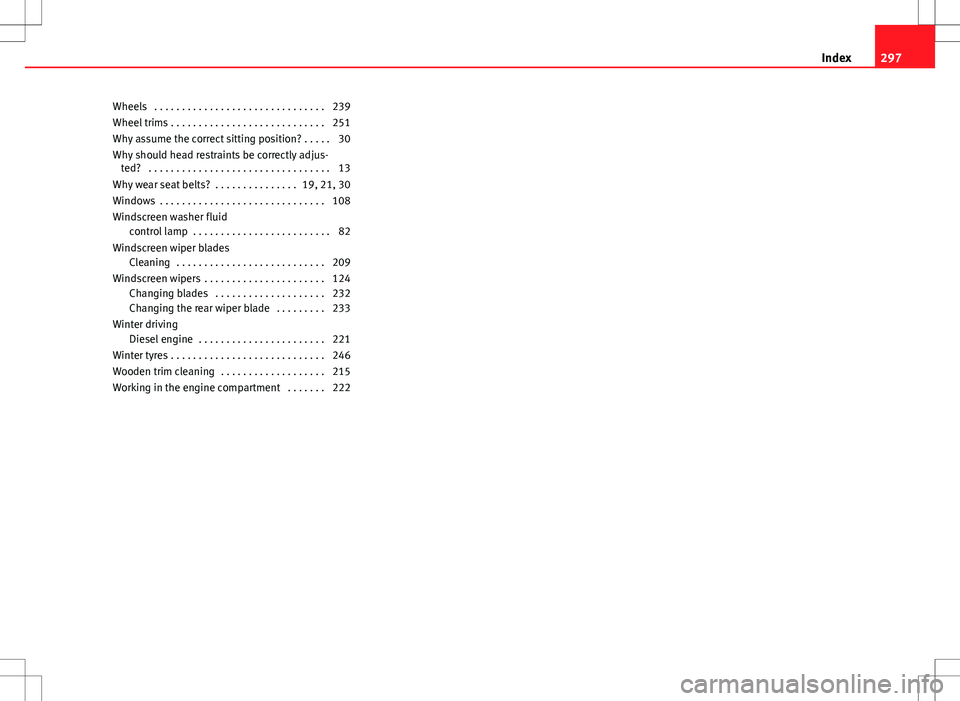
Wheels . . . . . . . . . . . . . . . . . . . . . . . . . . . . . . . 239
Wheel trims . . . . . . . . . . . . . . . . . . . . . . . . . . . . 251
Why assume the correct sitting position? . . . . . 30
Why should head restraints be correctly adjus-ted? . . . . . . . . . . . . . . . . . . . . . . . . . . . . . . . . . 13
Why wear seat belts? . . . . . . . . . . . . . . . 19, 21, 30
Windows . . . . . . . . . . . . . . . . . . . . . . . . . . . . . . 108
Windscreen washer fluid control lamp . . . . . . . . . . . . . . . . . . . . . . . . . 82
Windscreen wiper blades Cleaning . . . . . . . . . . . . . . . . . . . . . . . . . . . 209
Windscreen wipers . . . . . . . . . . . . . . . . . . . . . . 124 Changing blades . . . . . . . . . . . . . . . . . . . . 232
Changing the rear wiper blade . . . . . . . . . 233
Winter driving Diesel engine . . . . . . . . . . . . . . . . . . . . . . . 221
Winter tyres . . . . . . . . . . . . . . . . . . . . . . . . . . . . 246
Wooden trim cleaning . . . . . . . . . . . . . . . . . . . 215
Working in the engine compartment . . . . . . . 222
297
Index